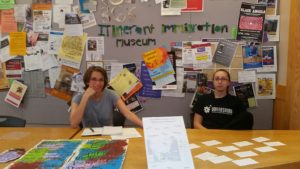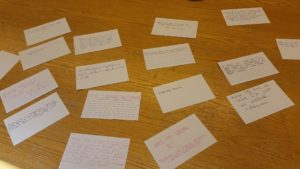
WCU students Kellie Wilcox (left) and Alexandra Cebula (right) presenting their immigration museum. Photo by Julia Lewis.
Students in Paul Worley’s Literature in Immigration class set up their final project on the second floor of the University Center at Western Carolina University today. Other students and faculty had the opportunity to both observe what the students had been learning throughout the semester, as well as share their own opinions on the matter using note cards presented by the students manning the project.
“Publicly oriented scholarship highlights how academics, and the humanities in particular, are not distant from a so-called ‘real world’ but very much an integral part of our daily lives,” said Worley about the final project. The course itself allowed these students to become informed on the issues involving immigration and develop their own opinions. They, in turn, used their knowledge and their final project as an opportunity to educate others on the topic.
Because immigration is a political theme that is controversial, these WCU students felt that it was important to shed some light on some of the realities of crossing borders. The students worked in shifts around class times in order to present the project from 9 a.m. to 4 p.m., so that there was at least one student sitting with the presentation for the duration of the exhibit. The students were presented with the project idea early on in the semester and have been brainstorming the final display for months, using the literature they read in class, as well as outside sources.
The feedback received from others spanned all across the spectrum, from comments like “Don’t build the wall,” to “Why not just ship all the illegal Mexicans out?” While the exposure for the exhibit was relatively small, those presenting the project were proud to share their work and what they had learned throughout the semester.

Students shared their own opinions on immigration using note cards. Photo by Julia Lewis.
“I’m really excited to do this,” group member Kellie Wilcox commented. “It’s neat to get everyone’s opinions on it.”
One student, who requested to remain anonymous, said “I feel like there’s these two extremes to the argument about immigration, and I think the truth can be found somewhere there in the middle.”
“There’s some sort of inherent bias in the system which allows other people from different places to have an easier time migrating than others,” another student said.
For more information on immigration data and statistics, visit the Department of Homeland Security’s website here.
For more information on the process it takes to gain legal status, visit the government’s website that provides links in regards to becoming a U.S. citizen.



